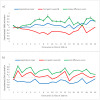The modulation of facial mimicry by attachment tendencies and their underlying affiliation motives in 3-year-olds: An EMG study
- PMID: 31260488
- PMCID: PMC6602198
- DOI: 10.1371/journal.pone.0218676
The modulation of facial mimicry by attachment tendencies and their underlying affiliation motives in 3-year-olds: An EMG study
Erratum in
-
Correction: The modulation of facial mimicry by attachment tendencies and their underlying affiliation motives in 3-year-olds: An EMG study.PLoS One. 2019 Nov 14;14(11):e0225493. doi: 10.1371/journal.pone.0225493. eCollection 2019. PLoS One. 2019. PMID: 31725804 Free PMC article.
Abstract
From early in life, facial mimicry represents an important example of implicit non-verbal communication. Facial mimicry is conceived of as the automatic tendency to mimic another person's facial expressions and is thought to serve as a social glue among interaction partners. Although in adults mimicry has been shown to be moderated by the social context and one's needs to affiliate with others, evidence from behavioural mimicry studies suggest that 3-year-olds do not yet show sensitivity to social dynamics. Here, we examined whether attachment tendencies, as a proxy for interindividual differences in affiliation motivation, modulates facial mimicry in 3-year-olds. Resistant and avoidant insecure attachment tendencies are characterized by high and low affiliation motivation, respectively, and these were hypothesized to lead to either enhancement or suppression of mimicry. Additionally, we hypothesized that these effects will be moderated by inhibitory control skills. Facial mimicry of happy and sad expressions was recorded with electromyography (EMG), attachment tendencies were assessed with a parent-report questionnaire and inhibitory control with the gift delay task. The final sample consisted of 42 children, with overall scores suggesting secure attachment. Our findings revealed that 3-year-olds mimicked happy and sad facial expressions. Moreover, resistant tendencies predicted enhanced sad but not happy facial mimicry, whereas avoidant tendencies were not significantly related to mimicry. These effects were not moderated by inhibitory control skills. In conclusion, these findings provide the first evidence for the modulation of mimicry by attachment tendencies and their underlying motivation for affiliation in young children, specifically for negatively-valenced emotional expressions.
Conflict of interest statement
The authors have declared that no competing interests exist.
Figures



Similar articles
-
Five-year-olds' facial mimicry following social ostracism is modulated by attachment security.PLoS One. 2020 Dec 29;15(12):e0240680. doi: 10.1371/journal.pone.0240680. eCollection 2020. PLoS One. 2020. PMID: 33373379 Free PMC article.
-
No evidence for modulation of facial mimicry by attachment tendencies in adulthood: an EMG investigation.J Soc Psychol. 2024 Jan 2;164(1):12-26. doi: 10.1080/00224545.2021.1973946. Epub 2021 Sep 30. J Soc Psychol. 2024. PMID: 34590534
-
Naltrexone increases negatively-valenced facial responses to happy faces in female participants.Psychoneuroendocrinology. 2016 Dec;74:65-68. doi: 10.1016/j.psyneuen.2016.08.022. Epub 2016 Aug 23. Psychoneuroendocrinology. 2016. PMID: 27588701 Clinical Trial.
-
Emotional mimicry as social regulation.Pers Soc Psychol Rev. 2013 May;17(2):142-57. doi: 10.1177/1088868312472607. Epub 2013 Jan 24. Pers Soc Psychol Rev. 2013. PMID: 23348982 Review.
-
The antecedents and consequences of human behavioral mimicry.Annu Rev Psychol. 2013;64:285-308. doi: 10.1146/annurev-psych-113011-143754. Epub 2012 Sep 27. Annu Rev Psychol. 2013. PMID: 23020640 Review.
Cited by
-
Optimal processing of surface facial EMG to identify emotional expressions: A data-driven approach.Behav Res Methods. 2024 Oct;56(7):7331-7344. doi: 10.3758/s13428-024-02421-4. Epub 2024 May 21. Behav Res Methods. 2024. PMID: 38773029 Free PMC article.
-
Influence of child and adult faces with face masks on emotion perception and facial mimicry.Sci Rep. 2023 Sep 8;13(1):14848. doi: 10.1038/s41598-023-40007-w. Sci Rep. 2023. PMID: 37684246 Free PMC article.
-
Applicability of a Novel Attunement Instrument and Its Relationship to Parental Sensitivity in Infants With and Without Visual Impairments.Front Psychol. 2022 May 3;13:872114. doi: 10.3389/fpsyg.2022.872114. eCollection 2022. Front Psychol. 2022. PMID: 35592146 Free PMC article.
-
Five-year-olds' facial mimicry following social ostracism is modulated by attachment security.PLoS One. 2020 Dec 29;15(12):e0240680. doi: 10.1371/journal.pone.0240680. eCollection 2020. PLoS One. 2020. PMID: 33373379 Free PMC article.
-
Correction: The modulation of facial mimicry by attachment tendencies and their underlying affiliation motives in 3-year-olds: An EMG study.PLoS One. 2019 Nov 14;14(11):e0225493. doi: 10.1371/journal.pone.0225493. eCollection 2019. PLoS One. 2019. PMID: 31725804 Free PMC article.
References
-
- Brazelton TB, Koslowski B, Main M. The origins of reciprocity: The early mother-infant interaction. 1974. 10.1016/S0163-6383(80)80014-2. - DOI
-
- Užgiris IČ, Benson JB, Kruper JC, Vasek ME. Contextual influences on imitative interactions between mothers and infants Action in social context: Springer; 1989. p. 103–27. 10.1007/978-1-4757-9000-9_4. - DOI
-
- Bigelow AE, Power M, Bulmer M, Gerrior K. The relation between mothers’ mirroring of infants’ behavior and maternal mind‐mindedness. Infancy. 2015;20(3):263–82. 10.1111/infa.12079. - DOI
Publication types
MeSH terms
Grants and funding
LinkOut - more resources
Full Text Sources
Medical


